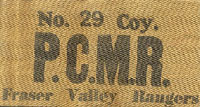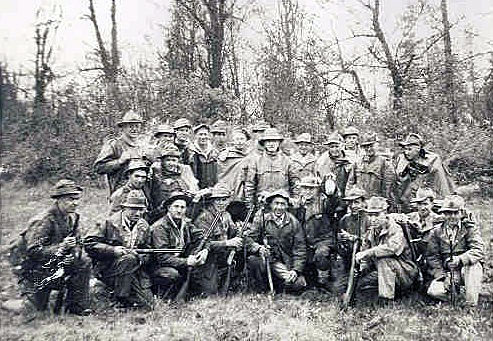British Columbia’s Own Home Guard
They began as the Coastal Defence Guards and were finally recognized as the Pacific Coast Militia Rangers (PCMR). The PCMR were unique to the west coast of Canada and were formed in early 1942 to protect British Columbia (BC) and calm public unease over possible enemy activities.

PCMR armband for No. 29 Company (Based in British Columbia’s Fraser Valley) CFB Esquimalt Naval & Military Museum collection.
After the attack at Pearl Harbour and declaration of war against Japan, patrols of BC’s rugged country appeared to be a necessity, one that could not be carried out by local militia forces, who were deemed more suited to populated areas.
Experienced men such as loggers, trappers, prospectors and ranchers were sought for this distinctive role. These men had knowledge of the local topography and terrain. Those who were close to populated centres were trained and employed at a local Ranger Training Camp in intelligence duties and local defence against minor raids. They were also instructed in tactical situations that included observation, especially coast watching against the possible Japanese invasion, anti-sabotage measures and protection of lines of communication and transportation.
As these newly formed companies of PCMR were so geographically spread out, many could not attend a training camp. Those who did attend were also trained in methods of instruction. This enabled them to pass on information to their own personnel upon their return.
Training continued to be an issue and so it was determined that a training publication would have to be created in order to meet the needs of this widely dispersed force. “The Ranger“, as it came to be known, was issued on September 1, 1942 and was filled with useful information that every well-rounded Ranger should know, such as: “Know where to shoot“, “Edible plants of BC“, “Dig or Die“, and “What can you do with a tarp?“. Age was not necessarily a consideration in the enlistment of these rugged men.
It was observed that, “young lads . . . in outlying areas were extremely valuable. Boys of 15 years and up proved to be good shots, could handle an axe, and were valuable as guides to city bred men.” Even those considered to be too old to join the war effort were able to contribute to the protection of BC.

PCMR Rangers – No. 29 Company, which was based in British Columbia’s Fraser Valley. Photo Catalogue No. 1996.005.205 CFB Esquimalt Naval & Military Museum Archives.
The PCMR’s early months were met with a distinct lack of supplies in appropriate clothing and weaponry. This changed, however, after the first Japanese incendiary balloons and a standard kit issue was developed to include: steel helmets, cloth “dry-bak” shooting hat, armbands, cloth “dry-bak” cruiser coat with shoulder straps, cloth “dry-bak” trousers and battle dress drill blouse with .303 rifles issued. Although the PCMR never engaged the enemy they played a crucial role in establishing a sense of purpose in those who were unable to go overseas for whatever reason.
Rural communities also gained a feeling of security knowing that there were able-bodied men on patrol at many of BC’s remote locales. All in an effort to deter the potential invading marauders whether by air, land or sea.
Finally on September 30, 1945 at Brockton Point Oval, the PCMR were stood down. At the ceremony, Major General F.F. Worthington noted that, “the citizens of this country owe you a great debt of gratitude for the services you have rendered in the defence of their homes.”
Please note: the museum does not have nominal rolls, service numbers or service records for individuals who served in the PCMR. Because these military personnel records were never placed in Library and Archives Canada’s custody, there is, regrettably, no information available through this source either. It is Library and Archive’s Canada’s understanding that these records no longer exist.
By Debbie Towell
Museum Curator
 CFB Esquimalt Naval and Military Museum
CFB Esquimalt Naval and Military Museum CFB Esquimalt Naval and Military Museum
CFB Esquimalt Naval and Military Museum CFB Esquimalt Naval and Military Museum
CFB Esquimalt Naval and Military Museum CFB Esquimalt Naval and Military Museum
CFB Esquimalt Naval and Military Museum CFB Esquimalt Naval and Military Museum
CFB Esquimalt Naval and Military Museum CFB Esquimalt Naval and Military Museum
CFB Esquimalt Naval and Military Museum CFB Esquimalt Naval and Military Museum
CFB Esquimalt Naval and Military Museum CFB Esquimalt Naval and Military Museum
CFB Esquimalt Naval and Military Museum CFB Esquimalt Naval and Military Museum
CFB Esquimalt Naval and Military Museum CFB Esquimalt Naval and Military Museum
CFB Esquimalt Naval and Military Museum CFB Esquimalt Naval and Military Museum
CFB Esquimalt Naval and Military Museum CFB Esquimalt Naval and Military Museum
CFB Esquimalt Naval and Military Museum CFB Esquimalt Naval and Military Museum
CFB Esquimalt Naval and Military Museum CFB Esquimalt Naval and Military Museum
CFB Esquimalt Naval and Military Museum